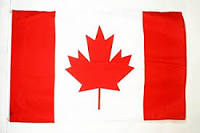Flagpoling in Canada – How to Cross the Border for good
Do you want to renew your study visa or work permit without wasting time? Flagpoling in Canada might be the best option for you. If you do not know what it is or how to go about it, there is no need to worry because all the information you need is right here.
This article will discuss everything you need about flagpole in Canada, including what flagpole is, the flagpole at the border crossing, how to flagpole without a visa, and IRCC Requirements for Flagpoling into Canada, among other helpful information.
What is Flagpoling in Canada?
Are you still confused about what flagpoling in Canada is? Don’t be! We’ll simplify everything for you. The term ‘flagpoling in Canada describes a process whereby foreign nationals in Canada enter the Canada – US border, enter the US briefly, and then apply for a visa upon re-entering Canada.
That is, a person who is not a Canadian but is already in Canada goes to a border and travels ‘around the flagpole’ before applying for a visa. Usually, there are many reasons why people flagpole, and it might be either to obtain a new temporary residence status such as a renewed study or work permit or to complete the PR process.
Typically, individuals with Temporary Resident Visas usually apply online or by paper. But, this process can take weeks or months to obtain an answer.
As a result, many individuals do not have much time, and if they go to a border, they may be processed immediately. However, the CBSA tries to limit Flagpoling because it places additional strain on border services. It is a perfectly legal process, and application processing is done on the spot.
Why Flagpole?
It’s a popular option to apply to Immigration, Refugees, and Citizenship Canada, where processing delays might take weeks and often several months. Here, candidates present themselves at the Canadian Port of Entry via flagpoling and are often processed in less than 30 minutes.
Traveling ‘around the flagpole‘ before presenting yourself at the border gave rise to the nickname or terminology.
Flagpoling in Canada at Border Crossing
This strategy, or flagpoling in Canada, is used to activate a new permanent resident status, renew a study or work permit, or modify an individual’s immigration status. Generally, when applying to the IRCC, people use this strategy to save time.
Indeed, when people flagpoles, they present themselves at a Canadian Port of Entry, where their application is usually completed in under 30 minutes. However, when it comes to flagpoling, the first challenge is crossing the border.
This isn’t a challenging process if you live near the border and have a car, but it can be a costly excursion if you don’t. As part of the flagpoling process, you must travel to the United States.
Again, you cannot complete the flagpoling process if you are not allowed to enter the United States. There’s also the possibility of getting caught between the two countries and being denied entry. Before making any decisions, it is usually a good idea to consult with an immigration consultant.
Who Can Flagpole?
Generally, study and work permit holders who want to renew their permits use flagpoling. They take all their documentation to a U.S. border crossing station, which may be processed in minutes.
It’s also utilized by temporary residents in Canada who want to confirm their status as permanent residents. It’s a quick and cheap alternative to waiting months for an IRCC appointment.
The following category of candidates can flagpole:
- Residents of visa-exempt countries with an LMIA-exempt job.
- Nationals of visa-exempt countries in possession of a positive LMIA.
- Nationals of the U.S., St. Pierre & Miquelon, and Greenland.
- Residents of visa-required countries who already have a work or study permit (flagpoling for the purposes of renewal).
IRCC Requirements to Flagpole
A candidate should inform the customs agent of his or her plan to directly flagpole after arriving at US border control. A slip with an administrative refusal to the US will be issued.
Candidates are then led to the Canadian border control, where, depending on the purpose of the flagpoling trip, the proper documentation must be presented.
What Documents Are Required by IRCC?
If you are eligible for flagpoling for renewing work permit or study permit or to validate your permanent residence status, you need to have all the necessary documents with you at the time of application, namely:
For Work Permit:
- Passport.
- Job contract signed by candidate and employer.
- Plus, if required: A positive LMIA, Provincial nomination certificate, Letter of support from the provincial nomination program, and up-to-date or valid medical examination certificate if employed in public health or have stayed for six months in certain countries.
For Study Permit:
- Official letter of acceptance from a recognized designated educational institution.
- Financial proof is required.
- In addition, if necessary: A letter of explanation, Québec Acceptance Certificate (CAQ), Custodian declaration (minors only), and various other documents.
For Permanent Residence Validation:
- Passport or travel document with visa sticker.
- Permanent residence confirmation or a letter from the Canadian visa office.
- Proof of legal status in Canada, such as one of the following: Study Permit, Work Permit, Temporary Residence Visa, or Other documents.
- Proof of implied status, for example, Payment receipt or Copy of extension application.
Problems facing people who flagpole?
While border processing is quick once you arrive, you must still travel to the border and join the queue. This is simple if you live near the border and have a car, but it can take time and money if you don’t. It will, however, be faster than applying to the IRCC.
Planning a trip to the United States in your flagpoling process is a good idea, as you will be formally denied entrance if you choose to flagpole without visiting the United States.
While this is acceptable as part of a one-time process, it will complicate matters in the future when you enter the United States since you will be questioned if you have ever been denied admission. This can be avoided by planning a day trip or excursion.
In principle, you could get caught in the middle of the two countries and be denied entry to both.
In which Canadian province can one flagpole?
You must enter Canada through land ports or ports of entry (POE) that handle immigration applications to flagpole. A list of land crossings between Canada and the United States is provided below:
- St-Armand/Philipsburg
- St-Bernard-de-Lacolle: Highway 15
- Niagara Falls Rainbow Bridge(Travellers only)
- Niagara Falls Whirlpool Bridge (NEXUS members only)
- Queenston Lewiston Bridge (Travellers and Commercial)
- Rainbow Bridge
- Sarnia (Blue Water Bridge)
- Sault Ste. Marie Bridge
- Peace Bridge
- Among many other border crossings not listed here.
Please Note: The above information may be subject to change. For the most up-to-date list, visit the CBSA website.
In addition, some border crossings may offer limited services or hours of operation. As a result, contact them or refer to reliable sources before approaching them.
Finally, should an individual meet these requirements, applications for a new study or work permit may be made at St-Bernard-de-Lacolle and St-Armand/Philipsburg as follows:
- Monday to Thursday, from noon to 7:00 p.m.
- Saturday, from 9:00 a.m. to 5:00 p.m.
FAQs
Is Flagpoling a Crime?
When temporary residents in Canada cross the border only for the goal of turning around and receiving quick immigration services at a port of entry, this is known as flagpoling. It’s a fully legal and considerably faster method of processing their documents.
What Is Flagpoling, and how does it Work?
When a person already in Canada departs and returns without crossing into the United States to activate a new permanent resident status or renew a study or work permit, this is known as flagpoling.
Do I need a visa to see the flagpole in the United States?
A US visa is not required for the flagpole. You won’t be flag-poling if you have a US visa. You’d have to travel to the United States and then return to Canada. This is because officials cannot refuse entry to the United States if you have a valid US visa.
What is the port of entry in Canada?
A Port of Entry (POE) is a location designated by the Government of Canada as an entry point into Canada. Typically, the first airport or land crossing that you stop at in Canada will be the Port of Entry.
Conclusion
In summary, when you flagpole, you do not need to worry about where to submit your application or whether to apply online or on paper. Instead, you hand over the required documents to a person standing before you, and the visa application is processed while you are physically present.
The process often takes about 30 minutes. It is the fastest way of renewing your work or study permit, especially if you don’t want to go through the delays by IRCC.
*#################*
*WELCOME TO UNCLE NE’S NEWSPAPER www.unclene.com*
*FOR JOB SEEKERS ON WHATSAPP, CLICK ON THIS LINK TO JOIN FOR DAILY JOB UPDATES:*
https://chat.whatsapp.com/Eisd4EQM7x5423sMG1G5h2
*Uncle Ne’s Job Group in Telegram with over 4870 members … when you join 500 previous jobs are sent to u:* https://chat.whatsapp.com/Eisd4EQM7x5423sMG1G5h2
Related posts:
*300 Fully Funded Gates Scholarships 2026 in the USA*
*Harvard Environmental Fellows Program 2026 in USA*
*1500 scholarships available opportunities, and Cameroon is eligible, many have been succeeding, Unc...
*Fully Funded Scholarships 2025 at UNIMORE, Italy*
*FCNY Community Planning Fellowship Applications Close June 9, 2025*
*Science & SciLifeLab Prize 2025 for Young Scientists*
*German Bonn International Fellowships 2025 Inviting Applications*
*National Higher Education Scholarship 2025 at Semmelweis University Hungary*
*SFR2CC Project Scholarship 2025/2026 at Kabale University*
*Moroccan Government Scholarships 2025 Open for International Students from Multiple Countries*
*Artificial Intelligence BSc Scholarship 2025 at University of Bradford*
*Telesat’s Women Scholarship 2025*
*Apply for ‘Study in Germany’ Ambassador Program 2025*
*Otsuka Toshimi Fully-funded Scholarship 2026 at APU Japan*
Multiple *US Embassies Inviting Applications for Fulbright Foreign Student Program 2026–2027*
*Fulbright Foreign Student Program for the 2026–2027 academic year is now officially open in several...
Discover more from UNCLE NE JOBS
Subscribe to get the latest posts sent to your email.

